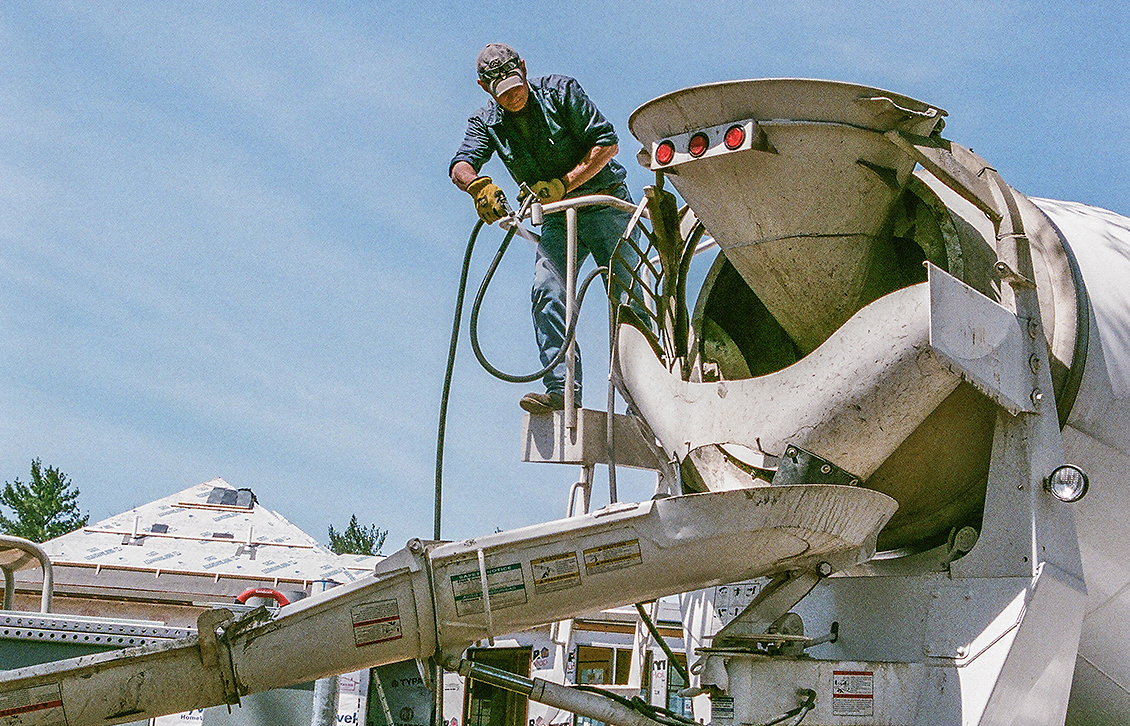Concrete
SAFETY NOTICE
Fresh, Unhardened concrete is very alkaline, and can cause severe alkali burns to your skin and eyes. The bleed water is particularly alkali, and you need to change any clothes that get soaked with this water quickly. Wash exposed skin with soap and water.
CONCRETE 101
Concrete is a mixture of about 75% aggregate (60% coarse #57s and 40% sand), 15% Cement, and the remainder is water, air and admixtures.
Fresh concrete has three important properties; slump, air content, and temperature.
Slump is the thickness, or flow characteristic of the concrete. Most concrete has a 4 to 6 inch slump. Very low slumps are difficult to place and work, they don’t even want to flow down the chute. High slumps may cause problems with forms bursting, aggregate segregation, or finishing.
Air content is the amount of air entrained in the concrete as a protection against damage from freezing and thawing. Concrete used indoors not subject to freeze and thaw usually has no air entrainment, which improves finishing and allows a hard trowled surface like inside Lowes to be created. Concrete used outdoors needs to have between 4% and 8% entrained air.
Finally, temperature is important because hot concrete, over 90 degrees, sets up quickly, and cold concrete, under 50 degrees, sets up slowly. Concrete must not freeze before it reaches 500 psi strength, which is usually in 24 hours.
Hardened concrete has one major important property, compressive strength which is measured in pounds per square inch, psi. This is how you order concrete, by the strength you want it to attain under laboratory conditions in 28 days. Most mixes are 3000, 3500 or 4000 psi. Some special mixes can go to 10,000 psi, and mixes for footers are fine at 2000 psi.
Concrete hardens by a chemical hydration process, not by drying out. It hardens best completely submerged in water! Therefore, adding water to concrete that is hours along in the hydration process does nothing to restore the plastic, workable properties of the mix. Adding water just dilutes and weakens the concrete, and will provide the temporary illusion that the concrete is once again fresh and workable. Every gallon of water added to the mix significantly weakens the concrete.
There are many chemicals that can be added to concrete to modify the properties of the mix.
Retarders will delay the set and provide additional time to deliver the concrete and work it into place. These admixtures retard the hydration process, and are most effective when added at the plant. A new generation of retarders can actually put concrete to sleep almost indefinitely.
Accelerators are just the opposite, and speed up the hydration process. They are often used in cold weather, which tends to slow down the process by itself. These admixtures can provide high early strengths, allowing rapid form removal, and are usually added on site. Non chloride accelerators are needed when you have reinforcing steel in the concrete to prevent corrosion, and are more expensive.
We use water reducing admixtures at the plant to reduce the amount of water needed to create a workable mix, and therefore increase strength.
You may choose to have us add super-plasticizers on site, which increases the slump of the concrete so that it flows around steel in forms better.
Fibers are added to control cracking in concrete. All concrete cracks. Reinforced concrete has to crack to work! There are two kinds of crack control, fibers, which are mixed in the concrete, and wire mesh which is place in the top one third of the slab. Both work, but it is difficult to get the wire mesh in the right place and often it ends up on the bottom of the slab where it does absolutely no good.
Reinforcing bar, rebar, is different than wire mesh, and is not intended to control cracking. It is designed to carry tensile load, and works in compliment to the compressive load carrying capability of the concrete.
Estimating concrete is much more scientific than aggregate, largely because we use forms, carefully prepared surfaces, and have lots of data regarding unit weights. Since concrete is also much more expensive, and perishable, we want a really good estimate. Ideally, you will have a wheelbarrow left when you are done.
First, calculate the volume of the work. Some concrete work can be complicated, and we are happy to help. Be careful with measurements, take them at more than one place and average them as necessary. The surface you are pouring on is important. Excavations tend to be deeper in the middle than at the edges where the forms are; this can be remedied with some fill prior to pouring. If you are pouring on #57s, which is very common, add 1/2” to the depth to allow for the irregularity of the aggregate. Larger aggregate requires a bigger adjustment.
When you have your volume in cubic feet, just divide by 27 to obtain cubic yards, and that’s all. It is nice to know that concrete weighs 150 pcf, or about 2 tons per cubic yard.
